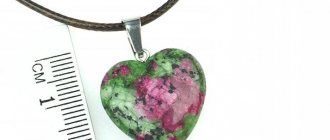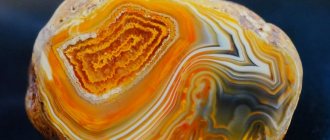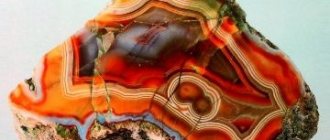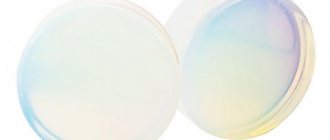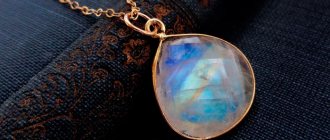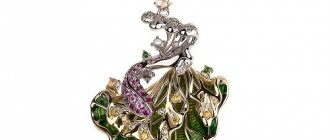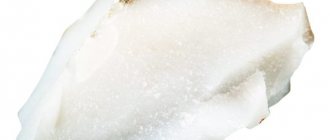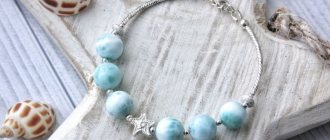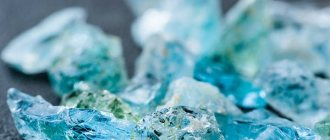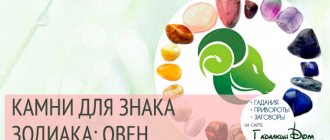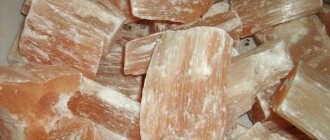Serpentine crystals of olivine pseudomorph. The sample size is approximately 6 x 6 cm. The white parts of the mineral are hydrotalcite. Norway, Buskerud province, Mudum municipality, Snarum, Dypingdal Serpentine-magnesite deposit
Coil
- local Russian (Ural) name for a whole group of minerals - polymorphic modifications of Mg6[Si4O10](OH)8 (antigorite, chrysotile, lizardite, etc.). Serpentine (Serpentine), similar in composition and properties of polymorphic modifications of magnesium silicate.
A type of serpentinite made from hydrous silicate of magnesium oxide can also be called a serpentine.
The name comes from the Latin word serpens, “snake”, due to the similarity of the pattern to snake skin. from lat.
Serpentine is an ornamental stone with original decorative properties. Viscosity, relative strength and ease of processing make this stone a popular ornamental, decorative, artistic and finishing material.
- Structure
- Properties
- Morphology
- Origin
- Application
- Classification
- Physical properties
- Optical properties
- Crystallographic properties
See also:
Agate
– price and medicinal, magical properties
Physical properties and structure of diamond
STRUCTURE
Serpentine pseudomorph of fosterite with white hydrotalcite. Sample size approximately 75 x 60 x 45 mm. Norway, Buskerud province, Mudum municipality, Snarum, Dypingdal Serpentine-magnesite deposit
Serpentine formula Mg6[Si4O10]*(OH)8 or 3MgO 2SiO2 2H2O. Chemical composition: MgO - 43.0%, SiO2 - 44.1%, H2O - 12.9%. The ratios of the components fluctuate somewhat, especially in differences similar to typical colloids, which are richer in water (usually up to 13–17%). Iron oxides FeO, Fe2O3 and nickel NiO are almost always present as impurities.
The crystal structure of all serpentines (including chrysotiles) is to a certain extent similar to the simple two-layer structure of kaolinite. The difference lies primarily in the fact that in serpentines the cations are concentrated in trioctahedral layers, in contrast to the dioctahedral layers in kaolinite packets. Further, the two-layer packets that make up the structure are characterized by the disproportion of trioctahedral “brucite” layers with hexagonal networks of silicon-oxygen tetrahedra. This disproportionality gives rise to the bending of the packets, which can maintain the direction of curvature in the case of uniform polarity in the direction of the vertices of the tetrahedrons, as occurs in chrysotiles, the structure of which turns out to be similar to tubes or rolls. In layered serpentines, the polarity of the networks periodically (in space) reverses, so that the structures alternate stripes composed of packets with differently directed vertices of tetrahedra, placed alternately on different sides of the trioctahedral cationic layer.
The elongation of the fibers coincides with the direction a. In addition to chrysotile with its inherent fibrous structure, all other representatives of serpentines, including antigorite, are found in the form of micro- and cryptocrystalline sheet aggregates. Most of them are colloidal or metacolloidal in nature.
History of the stone
The mineral began to be actively used by humans in the 18th century, although it was discovered much earlier. Its peculiar design, reminiscent of a snake's color, and the translation of the name from Latin (“snake”) led to the spread of the erroneous opinion that serpentine and serpentine are one stone. In fact, these are two independent but related minerals belonging to the same class of serpentinites. They have identical properties, but differ in chemical composition. The main element in serpentine is magnesium, while the base element in serpentine is magnesium oxide.
PROPERTIES
Green crystalline serpentine. Size 2 x 8 cm. USA, Oregon, Jackson Co., Applegate Mining District, Applegate Lake
Hardness varies from 2.5 to 4 depending on the amount of talc, softer than serpentine, or harder minerals, particularly amphiboles, present. The fracture is uneven, sometimes splintered, less often conchoidal. The luster in the fracture ranges from matte to greasy, less often pearlescent (in antigorite). Specific gravity 2.5-2.6. The cleavage is very perfect, but macroscopically it is observed only in larger lamellar varieties of antigorite: perfect along {001} and less perfect along {010}.
Refractive indices range between 1.55 and 1.80 (highest for those rich in iron). For antigorite pt = 1.55 1.58, for chrysotile pt = 1.54 1.55; the low refractive indices of the latter are due to a slightly higher water content and lower alumina content, which also explains its tubular shape. The birefringence of chrysotile (0.013) is slightly higher than that of antigorite (0.007). Most minerals are optically negative, only a few have a positive optical character (amesite, nepuite, chrysotile); 2V is about 50° for antigorite, 30° for chrysotile, other minerals are almost uniaxial.
Differences in color: antigorite is gray, white, green, bluish, chrysotile is greenish-yellow, sometimes white, gray, noble serpentine (ophite) is olive green. The line is white.
Dissolves in hydrochloric and sulfuric acids. It melts with difficulty and releases a large amount of water of crystallization in a closed glass tube.
How to distinguish from a fake
Despite its affordability, plastic is often passed off as a natural gem. The ways to identify a sample are as follows:
- Visual. Look carefully at the pattern - on natural stone it is poetic chaos, there can be no question of any system or repetition.
- Weight. Natural stones are much heavier than plastic.
- Heat. Hold the stone in your hands or place your palm on a large sample. Heating up quickly means it's fake. Natural stone heats up gradually.
But there is no need to try to scratch it - if the mineral is real, marks will definitely remain on it, because its strength is low.
MORPHOLOGY
The form of isolation is cryptocrystalline masses, fibrous aggregates. Chrysotile asbestos often fills cracks in serpentinites, with its fibers oriented perpendicular to the crack walls.
Composition of the serpentine group:
- Amesite (Amesite) - Mg2Al(SiAl)O5(OH)4
- Antigorite (Antigorite) - (Mg,Fe)3Si2O5(OH)4
- Berthierine - (Fe,Fe,Al,Mg)2-3(Si,Al)2O5(OH)4
- Brindleyite (Brindleyite, nimesite) - (Ni,Mg,Fe)2Al(SiAl)O5(OH)4
- Caryopilite (Karyopilite) - (Mn,Mg,Zn,Fe)3(Si,As)2O5 10(OH,Cl)4
- Chrysotile (Chrysotile) - Mg3(Si2O5)(OH)4
- Cronstedtite (Cronstedtite) - Fe2Fe(SiFe)O5(OH)4
- Fraipontite (Fraypontite) - (Zn,Al)3(Si,Al)2O5(OH)4
- Guidottiite (Guidottiite) - Mn2Fe3+(Fe3+SiO5)(OH)4
- Kellyite (Kellyite) - (Mn,Mg,Al)3(Si,Al)2O5(OH)4
- Lizardite (Lizardite) - Mg3Si2O5(OH)4
- Népouite (Nepouit) - Ni3Si2O5(OH)4
- Pecoraite - Ni3Si2O5(OH)4
Kaolinite – serpentine group:
- Dickite (Dickit) - l2(Si2O5)(OH)4
- Greenalite (Greenalite) - (Fe,Fe)2-3Si2O5(OH)4
- Halloysite - Al2(Si2O5)(OH)4
- Kaolinite (Kaolinite) - Al2(Si2O5)(OH)4
- Manandonite (Manandonite) - Li2Al4(Si2AlB)O10(OH)8
- Nacrite (Nakrit) - Al2(Si2O5)(OH)4
- Odinite - (Fe,Mg,Al,Fe,Ti,Mn)2.4((Si,Al)2O5)(OH)4
.
Price
On the Russian market you can buy all types of jewelry, materials for needlework, crafts, collectibles (price/rub.):
- ring + earrings (925° silver) – 3,200;
- beads (10-14 mm) – 21-68;
- pyramid – 1,600;
- cabochon inserts (20x30 mm, Russia) – 170-350;
- unprocessed nugget (760 g, Russia) – 750.
The world price is measured in kilograms - $5-10 per kg.
ORIGIN
Green serpentine in macro photography.
Size 15 mm. USA, Massachusetts, Essex Co., Newbury, Devil's Basin Origin - hydrothermal-metasomatic, sometimes hypergene (due to ultramafic rocks).
It is found in massifs of ultrabasic and basic rocks, in hydrothermally altered dolomites and dolomitic limestones. Serpentines are dense massive rocks widespread in nature with a hidden or finely crystalline and tangled fibrous structure. They are a product of regional or contact metamorphism of magnesium-rich ultramafic or carbonate rocks. They consist mainly of serpentine group minerals; minor minerals may contain admixtures of garnet, olivine, pyroxene, amphibole, as well as magnetite, chromite, carbonates, and talc.
Macroscopically, serpentine masses are recognized relatively easily by their characteristic dark green shades, variegated color, dense glue-like masses, greasy shine, the presence of asbestos veins, often observed sliding mirrors, low hardness. Antigorite serpentinites have characteristic gray shades, exceptional viscosity, felt when processing samples with a hammer, higher hardness compared to conventional serpentinites.
Associated minerals. Olivine, hypersthene, hornblende, plagioclase, magnetite, calcite.
Place of Birth
. Ural, North Caucasus, Armenia, Kazakhstan, Siberia (USSR); in the GDR, pyrope serpentinites near Sebnitz and Ansprung in the Ore Mountains, in the Saxon Granulite Mountains (Dresden, Karl-Marx-Stadt, Leipzig districts), garnet (pyrope) and bronzite serpentinites near Waldheim, garnet (pyrope) serpentinites near Börigen, bronzite serpentinites in in the vicinity of Hohenstein-Ernsttl, Waldenburg, Kushnapplell; In Germany, serpentinites are known in the Fichtel Mountains and in the vicinity of Wurlitz. Serpentinites are widely distributed in various regions of the world.
What does the mineral treat?
The spectrum of therapeutic effects of serpentine, or serpentine, is quite wide. The balls that are made from it are successfully used both for healing broken bones and for eliminating persistent insomnia. In the first case, the stone must be periodically rolled over the problem area, in the second, you must look at it carefully every day before going to bed.
It has been proven that serpentine can warn its owner about an approaching illness: in this case, it heats up unnaturally and literally burns the skin.
Interestingly, many pharmacists use serpentine utensils to prepare medications, believing that this enhances the effect of medicinal substances.
APPLICATION
Serpentine box decorated with gold. Russia 10 x 8 x 6.5 cm
Due to their low hardness and good decorative properties, coils have been used for centuries as an ornamental and decorative facing stone, and in rare cases for stone carving and cameo making. In Europe, serpentinites have been known as an ornamental stone for over 400 years and have been used to make countertops and apothecary vessels.
In Russia, serpentine has long been used for cladding interiors in palaces, in combination with other types of colored stones or metal - for the manufacture of stone-cutting products, as well as Florentine mosaics. In the royal suburban palaces of Russia - Gatchina and Pavlovsk - there were sets of artistic work, carved from coils, used in palace everyday life.
Chrysotile asbestos is used as a fireproof material, heat insulator, and alkali-resistant material. The most valuable asbestos is with a fiber length >8mm, but it is also used with lengths
Coil – Serpentine – X
2-3Si2O5(OH)4, where
X
= Mg, Fe2+, Fe3+, Ni, Al, Zn, Mn
| Molecular weight | |
| origin of name | Serpentine was named in 1564 by George Bauer from the Latin word “serpens” - “snakes” due to its color similar to snake skin. |
| IMA class | Silicates |
Amulets, talismans and amulets made of serpentine
The magical capabilities of the stone are used in several directions:
- Amulets with serpentine activate logical thinking and strengthen memory.
- Amulets resist negativity on the physical and mental planes, protecting the house not only from robbers or natural disasters, but also from unkind people.
- A coil is a mandatory attribute when performing rituals to establish connections with earthly or universal forces.
- The stone gives a true vision of the world and awakens intuition.
Serpentine is especially suitable for representatives of the following professions:
- entrepreneurs and businessmen;
- lawyers and jurists;
- for athletes and athletes.
Talismans in the form of a figurine, jewelry or a simple pebble will help them maximize their professional talents, ensure career growth, and success in business.
PHYSICAL PROPERTIES
| Mineral color | The color is yellow-green, dark green in thin fragments, bottle green in various shades to greenish-black, sometimes brownish-green. Often variegated in color (like the skin of a snake). Ophyte is often a pale olive green with a yellow tint. Antigorite is pale green, often gray, sometimes with a faint bluish tint. In thin plates, colorless or green to brown. |
| Stroke color | White |
| Transparency | From transparent, translucent to opaque |
| Shine | From dull dull to glassy, greasy |
| Cleavage | Very perfect, but macroscopically observed only in larger lamellar varieties of antigorite: perfect along {001} and less perfect along {010}. |
| Hardness (Mohs scale) | 2.5 - 4 (lizardite 2.5-3, antigorite - up to 3.5, opite - 2) |
| Kink | From smooth to conchoidal and splintered. |
| Strength | Fragile |
| Density (measured) | Density 2.2 – 3.4. (kerolite, kronstedtite), 2.62 (antigorite), 2.36-2.50 (chrysotile).1 |
| Radioactivity (GRapi) | 0 |
Who is it suitable for?
For those whose conscience prevents them from living happily and earning a lot. This:
- lawyers;
- lawyers;
- traders;
- businessmen.
Students will also find the snake decoration useful. The snake is not only cunning, but also smart.
Is Serpentine Right for You?
Not really
Zodiac for the serpentine
The gem can be used by Virgos and Capricorns. Provided they have a realistic outlook on life.
Absolutely contraindicated for Cancers and Pisces. The serpentine will subjugate them to any strong evil will.
It is difficult for Gemini to cope with the difficult nature of serpentine.
Expert opinion
Semenishcheva Polina
Specialist in mineralogy. Graduated from St. Petersburg Mining University.
If you really want to wear a “snake stone”, wear the jewelry a couple of times a week, not more often.
Element
Earth
Air
Planets
Astrologers do not agree. Some give the gem to Pluto.
Energy
Yin
OPTICAL PROPERTIES
| Type | Biaxial – |
| Refractive indices | fluctuate between 1.55 and 1.80 (highest value for those rich in iron). For antigorite pt = 1.55 1.58, for chrysotile pt = 1.54 1.55; the low refractive indices of the latter are due to a slightly higher water content and lower alumina content, which also explains its tubular shape. |
| Maximum birefringence | chrysotile (0.013) is slightly higher than antigorite (0.007) |
| Optical relief | |
| Pleochroism | Absent |
| Diffusion | No |
| Luminescence in ultraviolet radiation |
